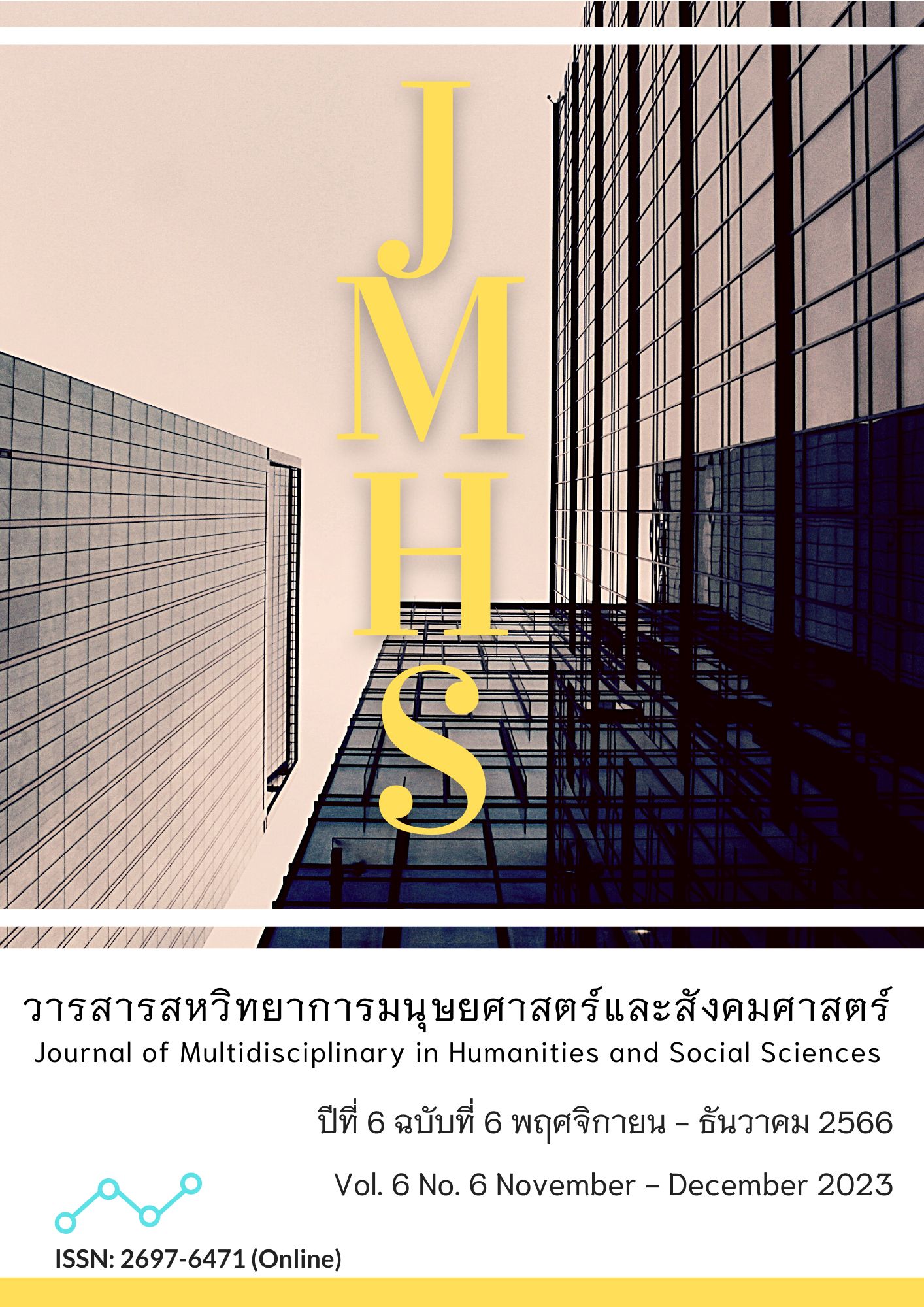Husband Rapes His Wife-Wife Rapes Her Husband: The Consideration According to the Third of Five Precepts, Kâmesumicchâcârâ
Main Article Content
Abstract
This research article was documentary research using the method of analyzing the contents of the Tripitakas, commentaries, books, and other related research. It aimed to analyze the issue of coerced sex in different cases as follows: 1) a woman being raped by a man and a man being raped by a woman; 2) a man being raped by a man and a woman being raped by a woman; and 3) a wife being raped by her husband and a husband being raped by his wife, in the context of Indian and Thai societies. It found out that: Firstly, the first two cases must be considered by the three components of the 3rd Precept, i.e., sexual intercourse by coercion, in the context of Indian and Thai societies. Regarding such acts in an Indian society, it would be considered that third parties, such as the victim’s husband or guardian, are being violated. Therefore, when a man rapes a woman, he commits immorality while she does not. As in the case where a woman rapes a man, neither of them is wrong. In Thai society, it is considered that the victim, regardless of sex, which is the second person, is directly violated. Thus, the perpetrator is considered to be violating this precept. Secondly, Indian society assumes that in the case where a man rapes another man or a woman rapes another woman, both parties are not violating the precepts. In contrast, in Thai society, it is considered that the perpetrator only violates the precepts. Finally, Indian society considers spousal coerced sex not a misconduct but an inappropriate act because the husband and wife should show virtue and kindness towards each other. In Thai society, it is considered that the perpetrator alone violates the precept.
Article Details

This work is licensed under a Creative Commons Attribution-NonCommercial-NoDerivatives 4.0 International License.
Views and opinions appearing in the Journal it is the responsibility of the author of the article, and does not constitute the view and responsibility of the editorial team.
References
คณะกรรมการร่างรัฐธรรมนูญ. (2560). รัฐธรรมนูญแห่งราชอาณาจักรไทย. กรุงเทพฯ: สำนักงานเลขาธิการสภาผู้แทนราษฎร. สืบค้นจาก https://cdc.parliament.go.th/draftconstitution2/ewt_dl_link.php?nid=1038&filename=index
คูณ โทขันธ์. (2537). พุทธศาสนากับชีวิตประจำวัน. กรุงเทพฯ: โอเดียนสโตร์.
คูณ โทขันธ์. (2545). พุทธศาสนากับสังคมและวัฒนธรรม. กรุงเทพฯ: โอเดียนสโตร์.
จุฑารัตน์ เอื้ออำนวย. (2544). ทำไมต้องข่มขืน!!. วารสารสังคมศาสตร์, 32(2), 136-148. สืบค้นจาก http://www.library.polsci.chula.ac.th/dl/55729eb6ca7a72e359e273bd0f9f4513
ชำนาญ จันทร์เรือง. (2550, 28 กันยายน). บทความ: หญิงข่มขืนชายเป็นความผิดทางอาญาแล้ว. ประชาไทย/ข่าว. สืบค้นจาก https://prachatai.com/journal/2007/09/14311
ธัชพงษ์ วงษ์เหรียญทอง และ กษมา เดชรักษา. (2565). สิทธิมนุษยชนกับมาตรการทางกฎหมายในการแสดงออกซึ่งลักษณะการเหยียดเชื้อชาติและสีผิวในประเทศไทย. วารสารสหวิทยาการมนุษยศาสตร์และสังคมศาสตร์, 5(2), 717-726. สืบค้นจาก https://so04.tci-thaijo.org/index.php/jmhs1_s/article/view/ 258137/175253
ปิ่น มุทุกันต์. (2536). คำบรรยายพุทธศาสตร์ ภาค 1 ฉบับฉลอง 25 พุทธศตวรรษ. กรุงเทพฯ: คลังวิทยา.
พระครูสังฆรักษ์อำนาจ เขมปญฺโญ. (2554). พระพุทธศาสนากับปัญหาจริยธรรม เรื่องการละเมิดสิทธิในทรัพย์สินทางปัญญาในสังคมไทย(วิทยานิพนธ์พุทธศาสตรดุษฎีบัณฑิต). มหาวิทยาลัยมหาจุฬาลงกรณราชวิทยาลัย.
พระญาณวโรดม (สนธิ์ กิจฺจกาโร). (2543). ประมวลปัญหาและเฉลย เบญจศีลเบญจธรรมและอุโบสถศีล (สำหรับธรรมศึกษาชั้นตรี). (พิมพ์ครั้งที่ 13). กรุงเทพฯ: มหามกุฏราชวิทยาลัย.
พระพรหมคุณาภรณ์ (ป.อ.ปยุตฺโต). (2557). พุทธธรรมฉบับปรับขยาย. (พิมพ์ครั้งที่ 39). กรุงเทพฯ: มหาวิทยาลัยมหาจุฬาลงกรณราชวิทยาลัย.
พระมหาสมปอง มุทิโต. (2558). คัมภีร์อภิธานวรรณนา ปรับปรุง 2558. อุดรธานี: ศูนย์วิปัสสนากรรมฐานวิหารธรรม.
มหาจุฬาลงกรณราชวิทยาลัย. (2539). พระไตรปิฎกภาษาไทย ฉบับมหาจุฬาลงกรณราชวิทยาลัย. กรุงเทพฯ: มหาจุฬาลงกรณราชวิทยาลัย.
มหามกุฏราชวิทยาลัย. (2536). พระไตรปิฎกและอรรถกถาแปล 91 เล่ม ฉบับมหากุฏราชวิทยาลัย. (พิมพ์ครั้งที่ 3). กรุงเทพฯ: มหามกุฏราชวิทยาลัย.
มหามกุฏราชวิทยาลัย. (2560). มังคลัตถทีปนี แปล เล่ม 2. (พิมพ์ครั้งที่ 15). กรุงเทพฯ: มหามกุฏราชวิทยาลัย.
วศิน อินทสระ. (2540). หลักคำสอนในพระพุทธศาสนา (พุทธปรัชญาเถรวาท). (พิมพ์ครั้งที่ 5). กรุงเทพฯ: มหามกุฏราชวิทยาลัย.
วศิน อินทสระ. (2549). พุทธจริยศาสตร์. (พิมพ์ครั้งที่ 2). กรุงเทพฯ: ธรรมดา.
สมเด็จพระพุทธโฆษาจารย์ (ป.อ.ปยุตฺโต). (2565). พจนานุกรมพุทธศาสน์ ฉบับประมวลศัพท์. (พิมพ์ครั้งที่ 37). กรุงเทพฯ: สหธรรมิก.
สมเด็จพระมหาสมณเจ้า กรมพระยาวชิรญาณวโรรส. (2538). เบญจศีลเบญจธรรม: หลักสูตรธรรมศึกษาชั้นตรี. (พิมพ์ครั้งที่ 15). กรุงเทพฯ: มหามกุฏราชวิทยาลัย.
สมภาร พรมทา. (2548). พุทธศาสนากับปัญหาจริยศาสตร์ โสเภณี ทำแท้ง และการุณยฆาต. (พิมพ์ครั้งที่ 3). กรุงเทพฯ: จุฬาลงกรณ์มหาวิทยาลัย.
สำนักงานคณะกรรมการกฤษฎีกา. (2559). ประมวลกฎหมายอาญา ฉบับ Update ณ วันที่ 07/04/2559. สำนักงานคณะกรรมการกฤษฎีกา. สืบค้นจาก https://www.krisdika.go.th/librarian/get?sysid=772817&ext=pdf
สำนักงานคณะกรรมการสิทธิมนุษยชนแห่งชาติ. (2546). เส้นทางสู่สิทธิมนุษยชนศึกษา. (พิมพ์ครั้งที่ 2). กรุงเทพฯ: สร้างสื่อ.
สูติรัตน์ พีรยาวิจิตร และประยงค์ แสนบุราณ. (2562). การนำหลักพุทธธรรมทางพระพุทธศาสนามาประยุกต์ใช้กับปัญหาการข่มขืนในสังคมไทย. วารสารมนุษยศาสตร์วิชาการ, 26(1), 386-395. สืบค้นจาก https://so04.tci-thaijo.org/index.php/abc/article/view/101761/131903
อำนาจ ยอดทอง. (2563). พุทธศาสนาเถรวาทกับมุมมองจริยธรรมเกี่ยวกับเพศสัมพันธ์. วารสารสันติศึกษาปริทรรศน์ มจร, 8(3), 1177-1178. สืบค้นจาก https://so03.tci-thaijo.org/index.php/journal-peace/article/view/239906/165600
อำนาจ ยอดทอง. (2564). พุทธจริยธรรมเรื่องเพศสัมพันธ์กับหุ่นยนต์เอไอที่เป็นพลเมือง. วารสารศิลปการจัดการ, 5(3), 623. สืบค้นจาก https://so02.tci-
thaijo.org/index.php/jam/article/view/250946/169726
Collins, S. (2007). Remarks on the Third Precept: Adultery and Prostitution in Pāli Texts. Journal of the Pali Text Society, 29, 267. Retrieved from https://palitextsociety.org/wp-content/uploads/2022/01/JPTS_2007_XXIX.pdf
Ven. Pandita (Burma). (2019). Sexual Misconduct in Early Buddhist Ethics: A New Approach. Journal of Buddhist Ethics, 29, 151-158. Retrieved from https://blogs.dickinson.edu/buddhistethics/files/2019/07/Pandita_19_FD_3-1.pdf

